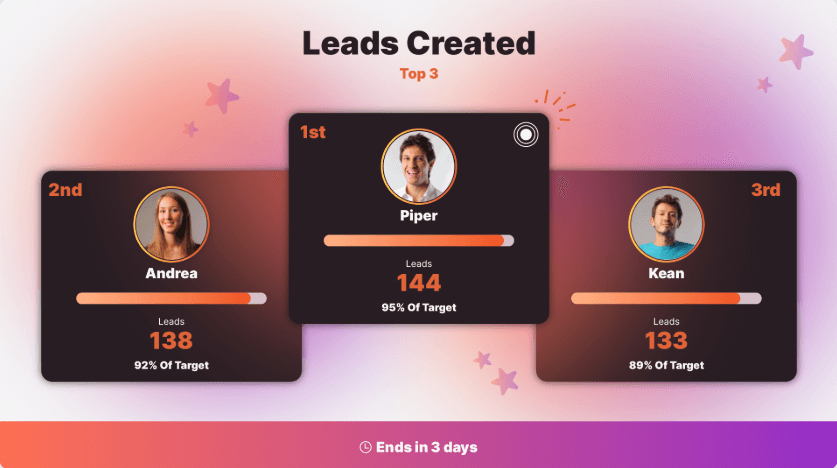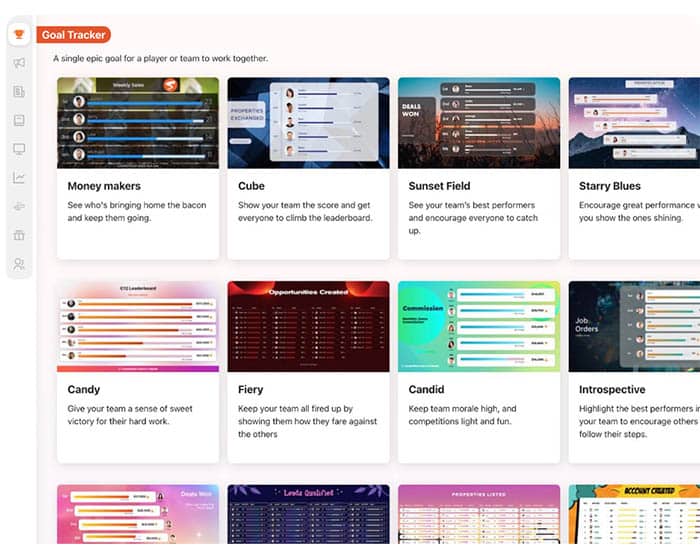In today’s competitive sales environment, motivation and performance are essential for success. One of the most effective tools to drive these outcomes is a sales leaderboard. By fostering a sense of sales competition, these leaderboards motivate sales teams by creating a competitive atmosphere. By transforming Salesforce reports into visual, interactive leaderboards, organizations can boost team engagement and performance while driving better use of Salesforce data. Here’s why every sales team using Salesforce should incorporate a leaderboard into their strategy.
Learn more about how to gamify Salesforce and boost adoption here.
What is a Sales Leaderboard?
A sales leaderboard is a powerful tool designed to track and display the performance of both individual sales reps and the entire sales team. It serves as a visual representation of key metrics and sales data, offering real-time insights into progress and rankings. By showcasing metrics such as revenue generated, customer acquisition costs, and sales cycle length, a sales leaderboard provides clear direction and helps identify areas for improvement.

Sales leaderboards are instrumental in fostering healthy competition among sales reps. When team members can see their standings in real-time, it motivates them to push harder and achieve their targets. This not only drives individual performance but also enhances overall team performance. By making key metrics visible, sales leaderboards ensure that everyone is aligned with the business goals and working towards common objectives.
1. Boosts Motivation Through Transparency
Salesforce is a treasure trove of data, but it’s often underutilized. Setting individual targets for sales representatives can enhance motivation and performance across the entire team. A sales leaderboard converts Salesforce reports into actionable insights, giving sales reps real-time visibility into their performance. This transparency encourages accountability and inspires reps to push harder to meet their goals.
By integrating Salesforce with a leaderboard, team members can instantly see how they rank based on metrics like closed deals, calls made, or revenue generated. This visibility eliminates ambiguity and helps sales reps focus on areas where they can improve.

Example: Imagine a rep sees they’re just a few points behind the top closer of the week. This can motivate them to make additional calls or focus on closing deals to climb the leaderboard. Over time, these small, consistent efforts lead to significant performance improvements.
2. Encourages Healthy Competition
Salesforce leaderboards bring gamification to your team’s workflow, creating a friendly competitive environment. When reps strive to outperform each other, they push their limits and achieve better results. Introducing cold calls as a metric can further enhance this competitive spirit. The key is using Salesforce data to fuel this competition.
With Salesforce leaderboards, team members can compete on metrics such as lead conversions, pipeline creation, or upsells. This keeps the competition aligned with organizational goals while keeping the team energized.
Pro Tip: Set up Salesforce-driven challenges like “Top Lead Converter of the Month” to maintain excitement and engagement. Use gamification elements like badges or progress bars to keep the competition fun and motivating.
3. Recognizes and Rewards Achievements
Leaderboards powered by Salesforce reports make it easy to recognize and reward top performers through a comprehensive reward system. Visibility into performance data means managers can highlight successes in real time, whether it’s closing a big deal or consistently generating new opportunities.
Recognition doesn’t have to stop at the top performer. Salesforce leaderboards allow you to spotlight improvements, milestones, or even team collaboration efforts. This inclusive approach ensures everyone feels valued and motivated.

Statistics to Consider: Companies that integrate recognition into their workflows see a 31% lower turnover rate, making leaderboards a valuable tool for boosting retention. Highlighting achievements directly tied to Salesforce data reinforces the importance of using the platform effectively.
4. Improves Team Collaboration
Salesforce leaderboards don’t just promote competition—they also encourage collaboration. By sharing strategies and tips, team members can collectively improve their performance and maximize the value they get from Salesforce. Integrating customer data into these strategies can further enhance sales planning and execution.
Collaboration can be especially effective when leaderboards highlight complementary strengths. For example, a rep who excels at generating leads can share their outreach strategies, while another rep who’s great at closing deals can provide negotiation tips.
Real-World Application: Teams using Salesforce leaderboards often schedule knowledge-sharing sessions to discuss what’s working. This creates a culture of support and continuous improvement, with every team member benefiting from shared best practices.
5. Tracks Progress Toward Goals
Salesforce is all about data-driven decision-making, and leaderboards enhance this by making progress visual. With a leaderboard, teams can track individual and collective performance against key goals, ensuring alignment and focus.
Leaderboards can track Salesforce KPIs like win rates, deal velocity, or customer retention rates. This focus on measurable outcomes ensures that every effort contributes directly to the team’s success.
Best Practice: Set up custom Salesforce reports to feed into your leaderboard. This allows you to highlight the metrics that matter most to your organization, whether it’s monthly revenue, meeting counts, or pipeline growth.

6. Increases Engagement with Gamification
One of the biggest challenges with Salesforce adoption is keeping users engaged. Leaderboards solve this by turning Salesforce activities into gamified experiences. Reps are more likely to log their activities, update opportunities, and engage with the platform when they see immediate results on the leaderboard.
Gamification keeps sales reps excited about using Salesforce, making the platform an integral part of their workflow. Even routine tasks like updating records or following up on leads become opportunities to earn points or climb the leaderboard.
Ideas to Implement:
- Award points for logging new opportunities, completing follow-ups, or closing deals in Salesforce.
- Use seasonal competitions like “Summer Sales Surge” to tie leaderboard engagement to broader campaigns.
Key Metrics to Track on a Sales Leaderboard
When setting up a sales leaderboard, it’s crucial to track the right key metrics to ensure it effectively drives sales performance and team success. Here are some essential metrics to consider:
- Sales Revenue: Track total sales revenue and monitor revenue growth over time to gauge overall performance.
- Conversion Rates: Measure the percentage of leads converted into customers to understand the effectiveness of your sales process.
- Customer Acquisition Costs: Keep an eye on the cost of acquiring new customers to ensure your sales efforts are cost-effective.
- Sales Pipeline: Monitor the number of leads in each stage of the sales pipeline to identify potential bottlenecks and opportunities.
- Sales Cycle Length: Track the average time it takes to close a sale to improve efficiency and shorten sales cycles.
- Sales Team Performance: Evaluate individual and team performance against targets to recognize top performers and areas needing improvement.
- Sales Metrics: Include metrics such as sales velocity, sales efficiency, and sales effectiveness to get a comprehensive view of sales performance.
By tracking these key metrics, sales teams can gain valuable insights into their performance, make data-driven decisions, and drive business growth.
Creating an Effective Sales Leaderboard

Creating an effective sales leaderboard requires careful planning and execution. Here are some tips to help you build a leaderboard that drives sales performance and team success:
- Use Real-Time Data: Ensure your sales leaderboard is up-to-date and accurate by integrating real-time data from your CRM or sales software.
- Track Key Metrics: Focus on key metrics such as sales revenue, conversion rates, and customer acquisition costs to drive meaningful performance improvements.
- Make It Visible: Display the sales leaderboard in a prominent location, such as a TV dashboard or a shared online platform, to encourage healthy competition and motivation.
- Use a Points System: Implement a points system to reward sales reps for achieving individual and team targets, making the leaderboard more engaging.
- Provide Feedback: Offer regular feedback and coaching to sales reps to help them improve their performance and reach their goals.
- Make It Fun: Incorporate gamification elements like badges, rewards, and seasonal competitions to keep the sales leaderboard exciting and engaging.
By following these tips, you can create a sales leaderboard that not only drives sales performance but also motivates sales reps and fosters healthy competition within your sales team.
Provides Valuable Insights for Managers
Salesforce leaderboards give managers a clear view of their team’s performance at a glance. These insights help identify top performers, spot areas for improvement, and allocate resources more effectively.
With a leaderboard, managers can drill down into Salesforce data to understand why certain reps are excelling. Are they focusing on high-value leads? Are they closing deals faster? This data-driven approach allows managers to replicate successful strategies across the team.
Manager Tip: Use leaderboard insights to tailor one-on-one coaching sessions. For instance, if a rep is struggling with follow-up conversions, focus on improving their email outreach or call scripts.
Transform Salesforce Data into Team Motivation
Salesforce is a powerful tool, but its true potential is unlocked when data becomes actionable. A sales leaderboard bridges the gap between raw Salesforce reports and team motivation, turning insights into action. By gamifying performance, recognizing achievements, and fostering collaboration, leaderboards help sales teams reach new heights.
Ready to maximize your Salesforce investment? Discover how Salesforce leaderboards can transform your team’s performance here.



